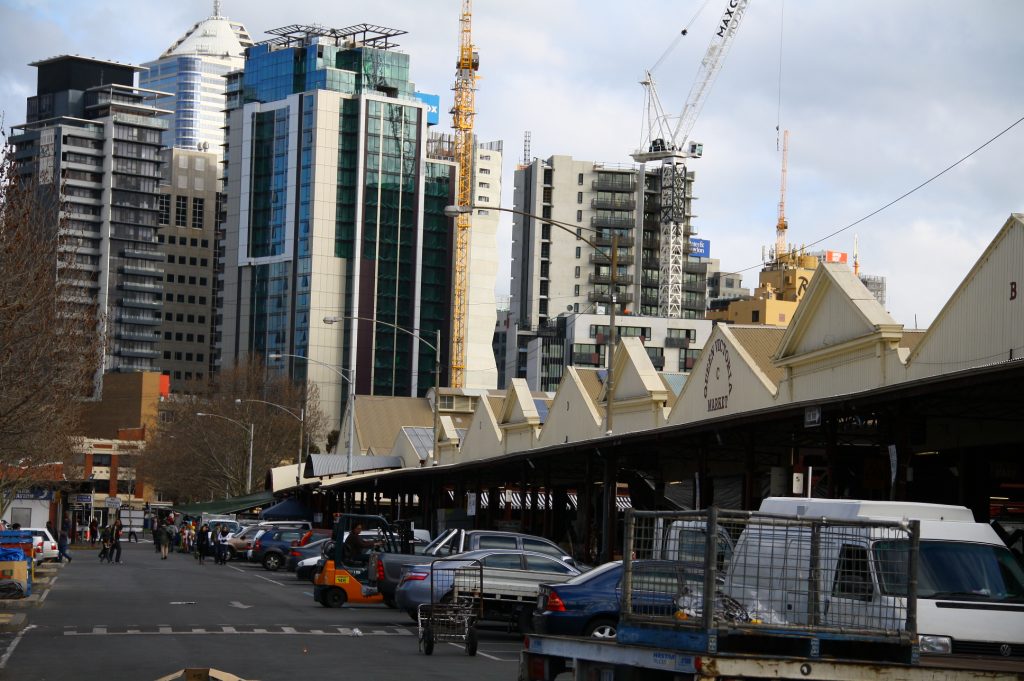Queen Vic Market planning controls set to be relaxed

The loss of height controls at the southern end of the site will allow development with unrestricted height over the sheds at the Franklin Street boundary. The National Trust and Melbourne Heritage Action (MHA) say this will, for the first time, result in the total erasure of the full historical extent of the market site and former cemetery.
The National Trust and our action group MHA have made a submission to City of Melbourne opposing proposed complete removal of height limits in the area covered by the existing DDO14, and the lack of recognition of the many surrounding heritage buildings. The proposed changes in Planning Scheme Amendment C245 mean that sites immediately adjacent to the market could end up with very tall buildings, with relatively small setbacks, and that many heritage buildings will end up facaded or demolished to allow for such towers, dominating the immediate market environs. We believe that some sense of the original purpose of the control, to step down from the higher built form of the central city to the very low scale of the Market, should be retained in some form.
The ’Key Attributes’’ of the QVM Precinct are defined statutorily in the Planning Scheme:
- The historic character of the precinct as a retail area.
- The generally simple, low-scale and remarkably intact example of a utilitarian form from the period of its construction. Taken as a whole, the Market and its component buildings are substantially intact in its 1923 form.
- The visual dominance of the Queen Victoria Market in the surrounding area.
Like many cultural landscapes, QVM accommodates a variety of different cultural realities. It has, for a very long time, been at the intersection of the drive to expand and upgrade the CBD, and the aspiration to conserve and resuscitate its open spaces and heritage values. Back in 1969, the Trust first surveyed and classified the site in it’s first campaign to “save the market”, in the prelude to the City of Melbourne’s 1970s plans for demolition and a $100M redevelopment. In 1991, the National Trust recognised QVM’s history as Melbourne’s first cemetery, and revised it’s classification to identify the social signficance of the site for the first time. By the time the QVM master planning process was first mooted in 2011, the Trust had been advocating for the protection of the QVM site for nearly 50 years. The 2013 announcement by Lord Mayor Robert Doyle for a $250M development program over 10 years was yet another false start in what amounts to decades of indecision.
In many ways, the 2015 discussion around QVM’s future is a very different environment than ever before. Not only have the more recent revisions of the Market’s statement of significance identified a broader range of values at the site, but the purchase of the adjacent Munro Buildings in late 2014 suggests a reconsideration of the market precinct boundary and its connections to North Melbourne and the greater CBD. The market site is now an important amenity to an increasing population of residents – interested in maintaining their neighbourhood – and the feasibility of the market’s facilities are being tested as market trading behaviours shift. QVM as a tourist destination took hold in the 1970s based largely on the visual and historic richness of the 19th Century Market halls and sheds. Forty years on, the CBD has come alive after hours and new opportunities for a 24 hour market precinct are being established in the open-air sheds by new demographics interested in the late night foodie scene.
The functional complexities of reshaping the market operationally and creating a world-class visitor experience, are overlaid – literally – on layers of history. QVM is a dynamic site, historically shifting and never staying the same for long periods. Yet, development and change in the physical environment at the QVM are regulated by the City of Melbourne planning scheme (principally regulating height) and the Heritage Act. The dynamic interplay of the tangible and intangible values at QVM, conflict with the static nature of these formal tools.
The Victorian Heritage Register statement of significance states that the Queen Victoria Market is of historical, archaeological, social, architectural and aesthetic significance to the State of Victoria. The regulatory framework is therefore fabric-driven and object-oriented, despite the site having social and historical significance. It is a classic example of the problem, described by Julian Smith, of moving ‘’from the object-centered universe of traditional heritage protection and management, to an ecological framework that considers the relationship among objects as much as their individual distinctiveness’’.
Perhaps as a means to address the intangible values at the site, the City – in particular the Lord Mayor – has emphasised that the master planning has at its heart a desire to retain “the authentic market experience”. Feedback from the City’s community engagement tool, Participate Melbourne informed the City’s aim to: “preserve the Queen Victoria Market’s heritage and authentic atmosphere, while allowing the market precinct to evolve to meet contemporary needs of traders, shoppers and the growing city.” It is unclear what the City really means by the “authentic”. The Trust finds that ultimately there is no single independently verifiable ‘’authentic’’ market experience. There is only a multiplicity of experiences.
According to the heritage consultants advising on the new QVM masterplan, the market boundaries to the east and south (comprising of Elizabeth, Queen, Therry, and Franklin streets) do not need additional heritage controls as they already consist of streetscapes containing both heritage and newer buildings. The “island site” characteristic is given force by the Heritage Victoria registration for the market. We dispute the claim that there is no strong physical link between the market and opposite buildings on Franklin Street, which is usually predicated on the fact that there is already some high rise development present. This does not reflect the realities of the interface and relationship with the adjoining agglomeration of mostly older buildings between Therry and Franklin, facing Queen and Elizabeth Streets, and those along the southern boundary on Franklin Street opposite the 1930 market sheds (some of which have been or are about to be demolished or facaded).
Many historic buildings remaining in the precinct relate to the market in both function and scale. They provide a messy, diverse, low scale streetscape of mostly older buildings facing the majority of the market site; those closest to the market on Therry and Queen are part of HO7, and have recently been reviewed, with the result that many are now C graded and so should be retained. There are a number of others that recently gained Heritage Overlays as part of C198, as did the whole of the row of building facing Elizabeth Street between Therry and A’Beckett Street.
There are now up to 30 or more heritage buildings that are affected by the lifting of height controls as part of the amendment. The National Trust and MHA jointly call for the existing height control DDO14 to remain, to ensure development will be “consistent with the scale and built form of the Market” in the immediate proximity to key market buildings.

Our Victoria Market has a (an?) unique character and should be preserved as a special enclave within the City of Melbourne. Developer greed should not be a consideration in the redevelopment.